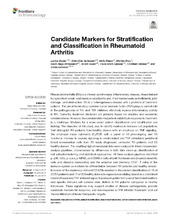| dc.contributor.author | Bader, Lucius | en_US |
| dc.contributor.author | Gullaksen, Stein-Erik | en_US |
| dc.contributor.author | Blaser, Nello | en_US |
| dc.contributor.author | Brun, Morten | en_US |
| dc.contributor.author | Bringeland, Gerd Haga | en_US |
| dc.contributor.author | Sulen, Andre | en_US |
| dc.contributor.author | Gjesdal, Clara Gram | en_US |
| dc.contributor.author | Vedeler, Christian A. | en_US |
| dc.contributor.author | Gavasso, Sonia | en_US |
| dc.date.accessioned | 2020-06-02T13:16:46Z | |
| dc.date.available | 2020-06-02T13:16:46Z | |
| dc.date.issued | 2019-07-05 | |
| dc.Published | Bader L, Gullaksen S, Blaser N, Brun M, Bringeland GH, Sulen A, Gjesdal C, Vedeler CA, Gavasso S. Candidate markers for stratification and classification in rheumatoid arthritis. Frontiers in Immunology. 2019;10:1488(JULY):1-8 | eng |
| dc.identifier.issn | 1664-3224 | |
| dc.identifier.uri | https://hdl.handle.net/1956/22434 | |
| dc.description.abstract | Rheumatoid arthritis (RA) is a chronic autoimmune, inflammatory disease, characterized by synovitis in small- and medium-sized joints and, if not treated early and efficiently, joint damage, and destruction. RA is a heterogeneous disease with a plethora of treatment options. The pro-inflammatory cytokine tumor necrosis factor (TNF) plays a central role in the pathogenesis of RA, and TNF inhibitors effectively repress inflammatory activity in RA. Currently, treatment decisions are primarily based on empirics and economic considerations. However, the considerable interpatient variability in response to treatment is a challenge. Markers for a more exact patient classification and stratification are lacking. The objective of this study was to identify markers in immune cell populations that distinguish RA patients from healthy donors with an emphasis on TNF signaling. We employed mass cytometry (CyTOF) with a panel of 13 phenotyping and 10 functional markers to explore signaling in unstimulated and TNF-stimulated peripheral blood mononuclear cells from 20 newly diagnosed, untreated RA patients and 20 healthy donors. The resulting high-dimensional data were analyzed in three independent analysis pipelines, characterized by differences in both data clean-up, identification of cell subsets/clustering and statistical approaches. All three analysis pipelines identified p-p38, IkBa, p-cJun, p-NFkB, and CD86 in cells of both the innate arm (myeloid dendritic cells and classical monocytes) and the adaptive arm (memory CD4+ T cells) of the immune system as markers for differentiation between RA patients and healthy donors. Inclusion of the markers p-Akt and CD120b resulted in the correct classification of 18 of 20 RA patients and 17 of 20 healthy donors in regression modeling based on a combined model of basal and TNF-induced signal. Expression patterns in a set of functional markers and specific immune cell subsets were distinct in RA patients compared to healthy individuals. These signatures may support studies of disease pathogenesis, provide candidate markers for response, and non-response to TNF inhibitor treatment, and aid the identification of future therapeutic targets. | en_US |
| dc.language.iso | eng | eng |
| dc.publisher | Frontiers | eng |
| dc.rights | Attribution CC BY | eng |
| dc.rights.uri | http://creativecommons.org/licenses/by/4.0/ | eng |
| dc.subject | rheumatoid arthritis | eng |
| dc.subject | patient stratification | eng |
| dc.subject | tumor necrosis factor | eng |
| dc.subject | tumor necrosis factor inhibitors | eng |
| dc.subject | mass cytometry | eng |
| dc.title | Candidate markers for stratification and classification in rheumatoid arthritis | en_US |
| dc.type | Peer reviewed | |
| dc.type | Journal article | |
| dc.date.updated | 2019-12-13T13:06:03Z | |
| dc.description.version | publishedVersion | en_US |
| dc.rights.holder | Copyright 2019 Bader, Gullaksen, Blaser, Brun, Bringeland, Sulen, Gjesdal, Vedeler and Gavasso. | |
| dc.identifier.doi | https://doi.org/10.3389/fimmu.2019.01488 | |
| dc.identifier.cristin | 1722012 | |
| dc.source.journal | Frontiers in Immunology | |

